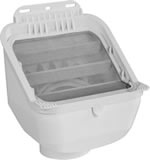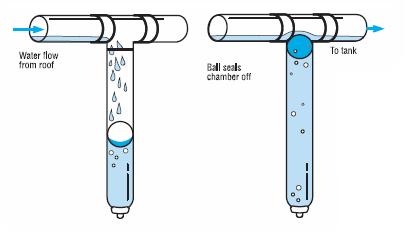Rainwater Catchment
In the following video, Greg discusses his own rainwater catchment system. He lives in the San Diego area, where, even though there is a drought, he is able to fill his tanks with over 18,000 gallons of water in a year.
He covers estimating rainwater capture capability, all of a system's components, moving water around, sizing the system, and permit considerations.
We apologize for some audio dropout problems in a few spots. This is due to the remote microphone equipment in use, and is not a problem with your computer or player. We've since purchased a better one for future videos!
Why rainwater?
Rainwater can be collected in quite large quantities and stored for long periods of time. Rainwater falls free from the sky and doesn't simply capture used city water (like greywater). It also helps prevent depletion of ground water resources and its collection may prevent erosion from runoff.
Since it is a clean source, it can be used for almost any purpose except human consumption (once collected, it is not considered potable). However, unlike greywater, it can be used above ground, sprayed, and come into contact with edible plant parts.
What can rain water be used for?
Though primarily used for landscape irrigation, including vegetable gardens. it could also have other outdoor uses, such as washing or livestock. A more sophisticated system could integrate the water into the building for flushing toilets and washing clothes. In fact, rainwater is free from many chemicals often found in ground water. Did you know that well water is not the best for potted plants?
Collected rainwater should not be considered potable because of the many factors that could pollute it, such as roofing materail, roof debris, gutter debris, wild animal "traces," etc.
Here's an article about harvesting rainwater for your garden: https://happydiyhome.com/how-to-harvest-rainwater/
What cannot be considered rainwater?
Water collected off the ground, or that has had contact with the ground, is considered storm water runoff, not rainwater. It is likely to have far more sediment and other issues, and is therefore a separate subject.
How much rain water can I collect?
Every 1,000 square feet of roof area can produce 628 US gallons of water per inch of rain (562 imperial gal (2555 liters) per 100 m²). When calculating your roof area, consider that your roof is usually larger than the square footage figure you normally associate with your house. A typical 2,400 square foot house, may have 3,000 feet of roof area when the garage, and eave hangovers are considered.
There is a small loss of the first few gallons for each rain event. This is taken up by the "first flush." The first flush is a device that intentionally diverts the first few gallons of each rain from your roof that typically contain dirt and other contaminants. There should be one first flush device for each collection point.
How much rain should can I collect?
You'll want to size your system for your longest "deficit." This will vary depending on your climate and your water use. For example, in Southern California it often does not rain much between March and October. So, if possible enough water needs to be stored to cover that entire period. In other areas, rain is much more frequent, and your deficit period will be much shorter. As a result, your storage needs will be much less.
How long can I store rainwater?
There is no limit to how long you can store rainwater. A dark pigmented tank to prevent algae growth and keeping out bugs are important factors. Tanks designed for rainwater catchment will meet these criteria.
Is it really clean?
Usually. It's clean enough for most outdoor landscape use, but the answer to that depends on several factors, the most obvious being the condition and makeup of your roof. Rainwater should not be used for drinking without proper treatment (not discussed here).
See this article for a discussion on possible contamination from room materials.
http://www.harvesth2o.com/RWH_good_bad_ugly.shtml
Important Installation Considerations
Gutter Guards and Leaf Eaters.
Gutter guards are an option that prevent debris from getting into the gutter and clogging the downspout. However, they must be cleaned perodically to prevent silt builtup in the gutter.

Leaf Eater
To guard against mosquitoes, the tank must be sealed against their entry with screens or tight seals at all joints.
A device such as a "Leaf Eater" screens debris and also provides an insect-proof barrier.
First Flush Devices

First Flush Device
A first-flush device should be incorporated into the design to bypass the first few gallons of water that is likely contaminated with dirt, bird poop, and other items from the roof and gutters.
Because rain water can be stored for long periods of time precautions need to be taken against algae growth and mosquitoes. Any tank intended for rainwater storage will be dark in color to inhibit algae growth.
Limitations on rain water
Some jurisdictions limit your right to collect rainwater. The legal aspects of this are changing to allow for more rainwater catchment. Check your local state, county, or city regulations.
Use
Prior to spraying, rainwater should be passed through a 100 micron filtter.
For underground use, no filtering is requried. This is applicable for diverting rainwater to underground French drains, thereby recharging ground water and preventing stormwater runoff.
Is rainwater catchment worth it? Factors to consider:
| Negative Factors | Positive Factors | |
| Landscape needs | llittle or live plants in landsaping | Plants that need watering |
| Rain frequency | Consistant rain throughout the year | Periods of litte or no rain |
| Accessibility | No room for tanks, local codes limiting tank palcement | House and tank areas are higher than the rest of the landscape. (i.e., no pump requried) |
| Construction type | Asphalt shingles or wood shakes | All metal roof, ceramic brick or cement tile roof |
| Climate | long periods of no rain (larger tank and collection area required) | Frequent rain (smaller tanks requried) |
| Price of Water/sewer | Cheap water available | High water prices and paired sewer charges |
| Social Leadership | Potentially "ugly" storage tanks | Improved home Resale value Good Patio conversation subject Plants like it! |
Configuration:
Once you collect your rainwater, you need your system set up to utilize it. Since it is often impractical to have only one storage tank for a whole house roof, and your use in different parts of the landscape may not match the capacity of the local tank, you'll want to be able to move some of that water around.
Size your system "for the deficit." You'll need to provide enough water to cover those periods where no rainwater is falling. Individual rain event intensity will also affect the system design. Collection (or surge) tanks need to be sized to collect the water from each rain event. Then, the surge tanks can drained to or pumped to a remote storage tank that does not need to be near the roof. On a flat property tank interconnects can be left open so that they all equalize together (wet conveyance).
Collecting or diverting water for ground water recharge/storm water mitigation do not require any treatment (filters, etc).
In my system (shown in the video), I interconnect my tanks with simple garden hoses and fittings. With just a gravity-feed connection (no pumps) I can equalize the water between any storage tanks at the same elevation (or transfer to a lower elevation tank).
I also pump the tanks located around my house (each about 1,000 gal) to a larger 5,000 gal storage tank at a higher elevation. This allows me to have my storage at other locations other than on the perimeter of my house and makes room for more collection at each rain event. If you are able to locate additional storage tank at a higher elevation, you'll only have to pump water into it, not out. You'll get about 1/2 psi of pressure for every foot of elevation that tank's water level is above the point of use.
In the video I show an inexpensive portable pump system I've put together with readily available parts. I use this pump to move water to my high-capacity tank, to fully pump one tank to another, or to produce higher pressure water for whatever need I have.
Resources
American Rainwater Catchment Systems Association
- Resources and Documents (lots of material to browse through)
- 2015 Rainwater Harvesting Manual (purchase)
There are many places to acquire the necessary parts. Here are a couple:
Downspout filters, diverters, first flush screens: http://www.rainharvest.com/filtration/pre-filtration.asp
Portable utility pump http://www.harborfreight.com/catalogsearch/result/index/?p=1&q=water+pump
Pump controllers http://www.rainharvest.com/pumps-and-controllers/pump-controllers.asp
Water meters http://www.rainharvest.com/pumps-and-controllers/water-meters.asp